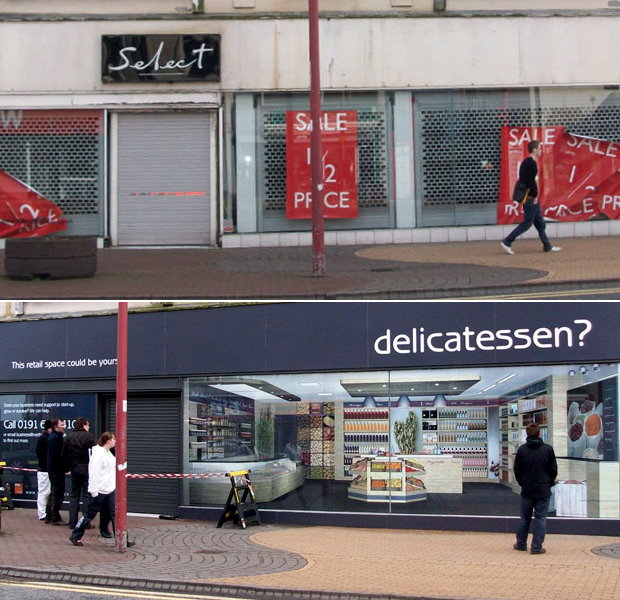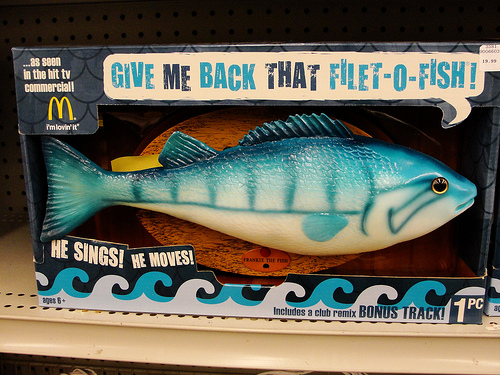 BRANDING OPERATION
BRANDING OPERATION
Selling real-life scrubs with references to a fictional hospital drama.
“Grey’s Anatomy” scrubs have been popular with medical professionals pretty much from the moment they were first produced.
Read the column in the October 3, 2010, New York Times Magazine, or here.
Discuss, make fun of, or praise this column to the skies at the Consumed Facebook page.
Posted Under:
Consumed,
Murketing
This post was written by Rob Walker on October 3, 2010
Comments Off on In The New York Times Magazine: “Grey’s Anatomy” scrubs

Andrew C. passes along this interesting item from Coolhunting. The paint company Delux, as I understand it, is setting out to colorfully paint “dreary” buildings around the world. The Delux site for the project, which is called Let’s Colour, says it will “work with communities all over the world.”
While there is clearly a murketing element to this, I’m cautiously impressed by the idea. The project’s — very colorful! — blog is here.

Friend of Murketing Rubi McGrory is rounding up foodstuffs “with logos built right in — when you eat the food, you eat the logo.”
This is in connection with an exhibition here in Savannah.
Examples:
Sweet Foods
- M&Ms
- Oreos
- Jelly Belly
- Sweet Tarts
- Lorna Doons
Not sweet Foods
- Carrs crackers
- Goldfish (the food is the logo)
- Chex mix (again, the food is the logo)
More savory examples particularly needed.
Thoughts? Please ask around! Answer below or on Rubi’s blog.
Thank you, brilliant and generous people!

Via PSFK: This brief report on the installation of fake storefronts to make downtown Tynesdale look less moribund than it really is. I’ve been trying to find more/better images, but I’m now giving up. My Google-fu and and Flickr-fu are inadequate, I guess; if you can help let me know.
Meanwhile, here’s my idea for the Tynesdale City Council: Make T-shirts advertising these hypothetical businesses. A nice minimalist slate-gray T with the “delicatessen?” on it could be good.
Also: In my last imaginary brand roundup I forgot to include the below development noted by Gladys Santiago:
If you’ve seen the Filet-O-Fish commercial McDonald’s airs for Lent, then you’re familiar with “Frankie the Fish” and his infectious jingle. Not being one to miss an opportunity to capitalize on kitschy sentimentality, McDonald’s has released a “Frankie the Fish” novelty frame that was obviously inspired by pop culture sensation, Big Mouth Billy Bass.
Here it is:

I guess this isn’t “imaginary,” but it’s pretty meta:
Ad campaign “riffs on” (e.g., swipes) a pop-culture-sensation product of the recent past; converts it into a commercial icon; and then takes it to retail, where the packaging continues to deliver the sell (“give me back that filet-o-fish,” which I gather is what the object actually sings) and in fact to tout the item’s tv-ad provenance.
That’s $29.98 at Taylor Gifts.
Posted Under:
Imaginary Brands,
Murketing
This post was written by Rob Walker on March 10, 2010
Comments Off on Imaginary brand variations
 A REAL FIND?
A REAL FIND?
A furniture maker hypes its wares by leaving them out with the trash.
In early November, a marketing agency’s “street team” began scattering a client’s products on the sidewalks of Manhattan and Brooklyn….
Read the column in the December 6, 2009, New York Times Magazine, or here.
Discuss, make fun of, or praise this column to the skies at the Consumed Facebook page.
Posted Under:
Consumed,
Murketing
This post was written by Rob Walker on December 5, 2009
Comments Off on In The New York Times Magazine: Blu Dot’s Real Good Chair promotion
In the months ahead, a certain niche branding consultant may or may not become a mainstream branding guru, as he publishes his first book — and, more to the point, promotes the shit out of it.
When it comes to book promotion, marketing consultants often have an advantage over authors who merely write for a living: employees. In fact that’s how I’m aware of this guy’s forthcoming branding blitz. A couple of months ago one of his employees sent Murketing.com an email (clearly a form letter) explaining that his boss is “trying to get together a promotional bonanza around the [book’s] release.” Thus he was being “proactive” and contacting “all the business and marketing blogs and see what we can do for them.” Contest? Interview? That was up to me; the consultant-author would do anything. “On your side,” his employee added, “anything you do with him is going to get an influx of readers to your blog due to his massive and loyal following.”
I had a hard time believing either the consultant or his employees are Murketing.com readers — particularly because I generally have zero interest in such schemes, as any actual reader of this site would know — so I asked why he was asking me. He replied that he was pretty sure he’d found this site listed on the Ad Age Power 150 rankings (or whatever that list is called; I’m not sure if I’m still on it, but it’s true that I used to be). In other words, he really didn’t know anything about this site, he was just going through lists, and saturation bombing. I thought that by itself might make for an interesting interview topic, but I never followed through.
More recently, the PR company that is also working on behalf of this same guru-in-the-making sent a fairly fancy traditional promo packet to the author of the New York Times Magazine’s Consumed column,which of course is also me. The pitch explained the consultant’s energetic “honesty,” and his mastery of “the internet and social media.” The release said the book reveals “how to build a personal brand.”
Obviously what’s of interest in all this is what it says about the new world of social-media marketing (this fellow’s area of expertise). Commonly social-media branding is described as, in theory, more authentic, transparent, and precise than traditional forms of commercial persuasion. Yet I’m often struck by how, in practice, it is largely an old formula poured into a newish bottle.
- The ethos here isn’t precision, it’s volume: If you have the resources to approach hundreds of blogs that might possibly buzz your product (even blogs you’ve never read), you have an advantage.
- That doesn’t replace the more old-school move of hiring a PR firm to hype the mainstream media, it supplements it. (Again, if you have the resources.) The main difference is that the old-school PR firm’s pitch is largely about your new-school social-media tactics. (Hey, Consumed guy: Check out this interview he did on some blog called Murketing.com!)
- Having said that, there is something of a new-media twist in “incentivizing,” as business types say, your potential online promoters, by suggesting that they will get more traffic by giving you more traffic, in a kind of word-of-mouth pyramid scheme. This doesn’t strike me as indicative of a new transparency or authenticity. At least when you see an ad, you know it’s an ad; if you read a blog rave about this guy, it might be from a real fan — or it might be from someone who just wanted to jump on the theoretical buzz bandwagon for their own reasons. (Or maybe I should say: For their own brand.)
None of which is to say that this marketing expert doesn’t have valuable “lessons” for all you brand-builders out there. I couldn’t tell you one way or the other. That’s because the one thing I didn’t get to look at, either as Murketing guy or as Consumed guy, was the actual book. Actually, I wonder if there is a lesson in that.
From the inbox:
Hello!
I am working at a marketing firm, and we are doing an on line campaign for one of our clients that has an on line printing company. I found your site! Bravo the content and pictures are truly inspiring, it makes me want to go home and get crafty! I thought that perhaps your site would be a great place to get a link to my clients site on Murketing.
I know it may not be something that you have done or considered in that past; using your site for advertising but I think that this would benefit both my client and yourself. I will be offering you monetary compensation to host a link. I hope that we can work something out! I can answer any questions you may have. Let me know what you think. Thanks in advance!
Cheers, [redacted]
You’re welcome!
 This weekend I opened a mysterious-looking letter that I assumed would be junk mail. It turned out to be from “The Credit and Collection Unit of BusinessWeek Magazine,” which had sent me a scary-looking “Invoice” and letter that suggested I am somehow in debt to their organization. “If you dispute this debt,” the form letter told me, I could write in with a reply pleading my case. “Failure to respond will result in further communication from this office.”
This weekend I opened a mysterious-looking letter that I assumed would be junk mail. It turned out to be from “The Credit and Collection Unit of BusinessWeek Magazine,” which had sent me a scary-looking “Invoice” and letter that suggested I am somehow in debt to their organization. “If you dispute this debt,” the form letter told me, I could write in with a reply pleading my case. “Failure to respond will result in further communication from this office.”
Whatever. In point of fact I merely decided not to renew my subscription. Obviously Business Week knew this, as they stopped sending me the magazine once my paid-up period ended. In other words: We’re square. No “debt” involved. (And I’m not sure that sending a menacing letter makes me anxious to rethink my decision at the moment. But that’s another story.)
So anyway I’m about to toss the thing in the trash when I notice something else:
An insert touting DirectTV. That’s right — an ad! Somehow, Business Week’s “collection” department has apparently managed to attract at least one sponsor!
Are you people kidding? Has this ever worked? I’m thinking anybody getting a letter like this is either a little light on cash, or simply annoyed that Business Week is treating him or her like a deadbeat for the non-offense of deciding not to subscribe to Business Week any longer. Why does DirecTV, or any business, want to associate itself with this moment in a consumer’s life? Does anybody receiving one of these things ever think: “Oh, man, this magazine is hassling me about my subscription. Oh, wait, check this out — I think I’ll try DirectTV!”
A little while ago I linked to what some say is the most amazing music video of the year. I agree: It’s impressive.
Today Kevin Kelly had an item about it, headline “Crowdsourced Music Video,” which linked to this interview with its creators. The interesting thing about this interview was the following question:
Most viewers recognized this as a professional effort, but it certainly made use of the amateur aesthetic and idea of collaboration. Where did the concept come from?
Actually, I take that back. The question (where did the concept come from?) isn’t interesting. What’s interesting is the phrase I’ve bolded, “the amateur aesthetic and the idea of collaboration.” It’s particularly interesting because despite this open acknowledgment that this video was not a product of amateurs, and the collaboration was more of an idea (that is, a whole bunch of people simply did what they were told) than a reality, it still evidently qualifies to some observers as an example of something that’s been “crowdsourced.”
If that’s the case — if the crowd’s job is basically to follow orders from well-funded visionary authorities (four directors, two of whom are “creatives” at the global ad agency BBH), and kinda look all crowdy-like while doing so — then what, exactly, does crowdsourcing mean?
Is it about amateurs, or about “the amateur aesthetic”?
Is it about collaboration, or about “the idea of collaboration”?
And given that I’ve just said I think the end result is a really great video, what difference does it make? Is this just a matter of people applying trendy words to something impressive, because the trendy words happen to encapsulate the the 2.0 dogma of the moment?
As you may have read, Starbucks is testing out the idea of removing the Starbucks name from some of its locations, remodeling and renaming them, so that they look more like neighborhood coffee places. A Starbucks brand honcho says the idea is to give these locations “a community personality.”
Insofar as these coffee shops remain, in reality, disguised outposts of a ubiquitous multinational, this is obviously a completely synthetic version of “community personality.” It’s reminiscent of the big breweries putting out new brands that look like craft beers, or mass-market clothing brands tweaking product lines to get the “handmade” look, among other examples. In this case it seems that Starbucks sent out some of their experts on this matters to sit around actual local coffee shops to take notes and crib ideas. One Seattle coffee shop owner, such visitors returned many times over the period of a year, toting “obnoxious folders that said ‘Observation.'”
Presumably such detailed ethnographic study is necessary, for the chain’s new indie-simulacrum locations to be sufficiently, you know, authentic.
Earlier today I saw, on a blog, a reference to a trailer for a documentary I hadn’t heard of but that sounded interesting. I clicked and went to a site called MovieWeb.com.
Before the trailer started, there was an ad (for Axe hair gel). When the trailer started, text ads popped up on the bottom of the video window, advertising other movie-trailer sites I might want to check out. And of course above the video window there was a banner ad, for a movie, and to the right another ad (for Axe).
That seems like an awful lot of sponsorship to deal with … just to watch what is, after all, an ad for a movie.
Everybody knows about advertising “clutter” — the proliferation of commercial persuasion messages through every conceivable medium. Consumers don’t like it for obvious reasons, but ad pros don’t like it easier: The more messages there are, the harder for theirs to get through, etc.
Consumer-in-control rhetoric aside, the evolutions of the media landscape have done nothing to reduce clutter. (Obviously this is dealt with in more detail in Buying In.) In fact the various technological advances described as empowering the consumer invariably inspire, or simply succumb to, more forms of marketing.
This is because, generally speaking, when commercial persuaders fight clutter, they way they do it is by creating more clutter. A recent Adweek piece is instructive on this score. It’s titled “The Clutter Busters.”
Stephen Quinn, CMO of Wal-Mart Stores U.S., says that the only clutter-proof medium he’s aware of is the one that the company created itself, the Walmart Smart Network….
When it’s fully rolled out next year, it will include some 27,000 in-store video screens in 2,700 stores. The content includes both infomercials and advertisements from Wal-Mart suppliers, and the schedules are customized to individual stores and shopping occasions.
Well, that’s a “clutter-proof medium” only in the sense that no unsanctioned brand can interfere with the messaging of Wal-Mart and its suppliers. From a consumer point of view the medium of an in-store shopping network, blasting infomercials and ads while you shop, is, in point of fact, an all-clutter medium.
And that’s what most of the examples in the piece seem to be: Media or content that is completely controlled by a single brand, thereby eliminating the “clutter” of other brands. (In Wal-Mart’s case, that also means a network of “select female bloggers” who will provide “tips” on Wal-Mart’s site, and its YouTube channel.)
Another way to distance a brand from traditional clutter is that increasingly popular murketing form: Inserting your brand directly in the entertainment, away from the (skippable) ads for other companies’ products. A new daytime talkshow, for instance, will have host Bonnie Hunt doing a beauty segment involving “Walgreens integrations.” Not just using Walgreens products but “actually shopping in our stores… with our beauty advisers,” a Walgreens exec explains.
That’s clutter-busting? Maybe to brand managers. But not to the rest of us.
Somebody was interviewing me today about the book and the current economy and all that, and the conversation turned to Tropicana bowing to consumer pressure (apparently) to junk its recent redesign. What does that episode say about the present state of the “secret dialogue between what we buy and who we are”?
Well, for one thing it’s an example of one manifestation of that dialogue becoming somewhat more open — in the sense that one of the things the Web does is make visible consumer sentiments that would have been harder to quantify in the past.
More interesting, though, I would suggest, is that the episode underscores the surprising degree to which consumers want to participate in this dialogue. By that I mean: If nobody cares about brands anymore (as various experts have claimed for years, and are claiming once again with the recession as the new rationale), then why in the world would anybody go to the trouble of emailing a company, or starting a Facebook group, about package design? After all, the juice didn’t change. So, you know, who cares?
Lots of people, that’s who. Marginal Utility picks up on a comment from some Tropicana exec that the decision was made because the brand’s “most loyal consumers” were supposedly unhappy: “That they bother to complain is precisely what makes them loyal,” Rob Horning writes. “Others would probably just buy something else without a second thought. Myself, I would prefer to be one of those others.”
To me, that’s definitely a more reasoned response: I mentioned that we at Murketing HQ disliked the new design, and responded by trying some alternatives. While we talk about this kind of consumer/design trivia all the time around here, it never occurs to us to get involved in some kind of Web-enabled protest movement, or at least not about the way a package looks.
After all, it’s not like the aesthetics of Tropicana is some kind of important issue worth rallying around — certainly nothing worth treating like a consumer-rights battle that pitted the grassroots against corporate power.
And yet, there’s at least some evidence that certain observers see this incident in precisely those terms. For example, Marginal Utility also noted the Kottke entry on the Tropicana episode, which declares: “We won!”
Ad Age notes Meetup’s recent-ish decision to start courting sponsors. The article says co-founder Scott Heiferman was originally against the idea, but changed his mind because group organizers “said it makes their meetings better.” Ad Age says:
Sponsorships take a lot of shapes, but all involve a monthly donation to the group to cover organizer fees, buy coffee or just provide a free venue for a book club. The idea is to keep it small, cheap and simple so it can scale. American Express Open, Huggies, Sony BMG and e-mail-device maker Peek are sponsoring thousands of entrepreneur, parenting, music, sports and moms’ groups around the country.
Also using the tactic are smaller brands such as Peek (which I had never heard of), the maker of “an email device” that is sponsoring “about 100 mom-focused Meetup groups.” Apparently it’s the brand’s biggest single marketing expense.
“The goal is to get Peek into the hands into people we build the device for and we think its perfect for,” said Marketing Manager Jeremy Downs.
That meant sending three Peeks to Melony James, organizer of the 224-member Toddler Adventure Group in San Jose, Calif. Peek also started depositing $30 a month in Ms. James’ Amazon account to cover her Meetup dues and snacks for the kids. “I like the Peek because it’s simple to use, not targeted at techies,” she said. “They pitched it quite well.”
Why is Peek doing that via her Amazon account?
Well, anyway, apart from that weird-ish detail, not particularly surprising, but worth noting, and keeping and eye on.
Posted Under:
Murketing,
The People's Marketing
This post was written by Rob Walker on February 16, 2009
Comments Off on Community and connection brought to you by…
 A story in the WSJ yesterday explained that Unilever’s famous “Campaign For Real Beauty” for its Dove products wasn’t working in China, where “women aren’t so bothered by the stunning models used in most beauty ads and aren’t driven to buy products promoted with so-called real faces.” Apparently the multinational has found what it hopes is a solution, by way of “Ugly Betty.” No, they aren’t simply sponsoring the Chinese version of the show — they’ve worked out a deal to basically produce a Chinese version of the show:
A story in the WSJ yesterday explained that Unilever’s famous “Campaign For Real Beauty” for its Dove products wasn’t working in China, where “women aren’t so bothered by the stunning models used in most beauty ads and aren’t driven to buy products promoted with so-called real faces.” Apparently the multinational has found what it hopes is a solution, by way of “Ugly Betty.” No, they aren’t simply sponsoring the Chinese version of the show — they’ve worked out a deal to basically produce a Chinese version of the show:
In an unusual move, Unilever’s ad-time-buying agency, WPP Group PLC’s Mindshare, brokered a deal to bring the format to Chinese TV, giving Unilever the right to exclusive ads and product placements during the show, as well as a script built around the company’s Chinese reformulation of the campaign for real beauty. …
On “Ugly Wudi,” protagonist Lin Wudi, who works at an ad agency, learns to unveil her own beauty, using Dove products and working on an imaginary ad campaign for the brand. …
In one episode, an actor playing the media director for Dove in China explains that an ad campaign that Wudi helped create epitomizes Dove’s view on beauty. “There are so many kinds of women and so many kinds of beauty,” he says. “This is exactly the message that Dove tries to put forth.”
 BRANDING OPERATION
BRANDING OPERATION



 "
"




 This weekend I opened a mysterious-looking letter that I assumed would be junk mail. It turned out to be from “The Credit and Collection Unit of BusinessWeek Magazine,” which had sent me a scary-looking “Invoice” and letter that suggested I am somehow in debt to their organization. “If you dispute this debt,” the form letter told me, I could write in with a reply pleading my case. “Failure to respond will result in further communication from this office.”
This weekend I opened a mysterious-looking letter that I assumed would be junk mail. It turned out to be from “The Credit and Collection Unit of BusinessWeek Magazine,” which had sent me a scary-looking “Invoice” and letter that suggested I am somehow in debt to their organization. “If you dispute this debt,” the form letter told me, I could write in with a reply pleading my case. “Failure to respond will result in further communication from this office.”












 Kim Fellner's book
Kim Fellner's book  A
A